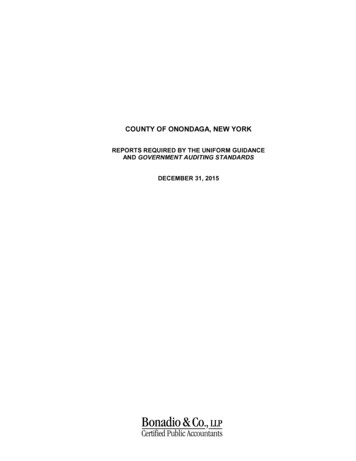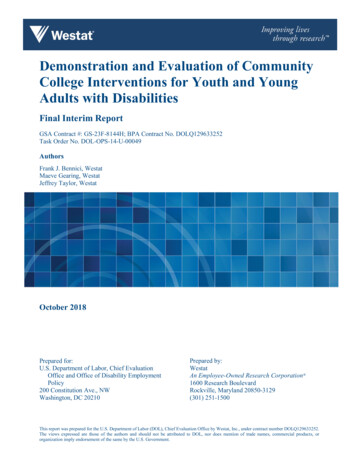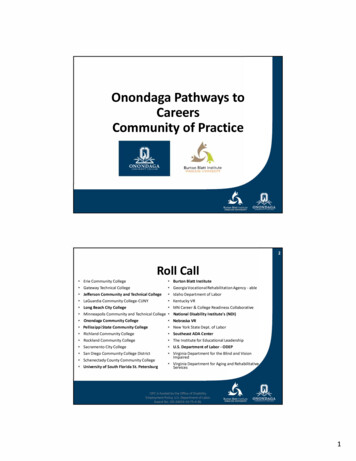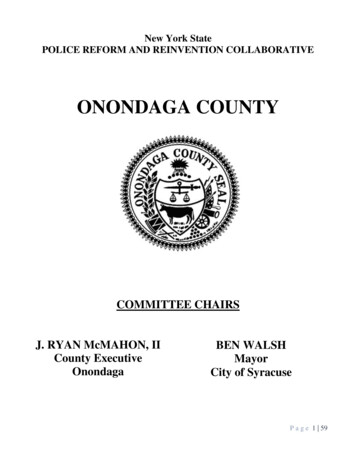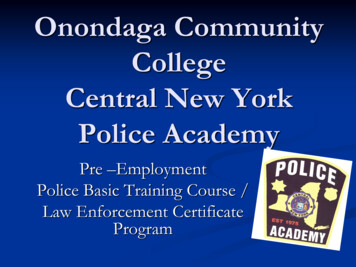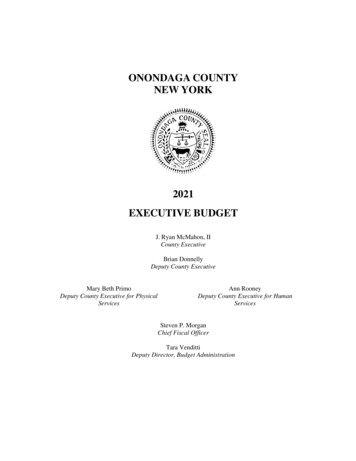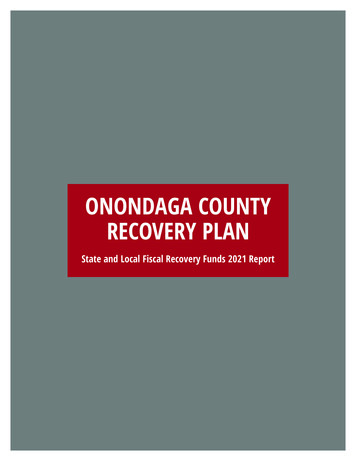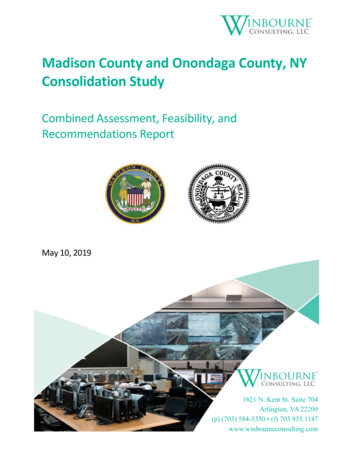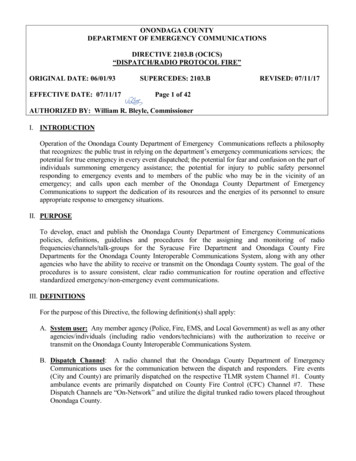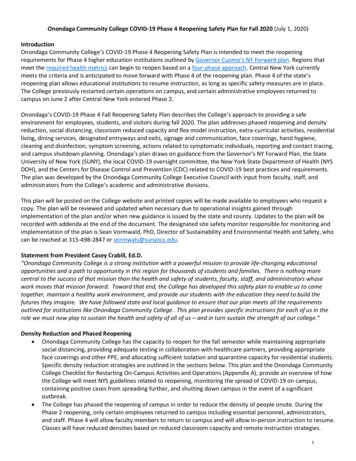
Transcription
Onondaga Community College COVID-19 Phase 4 Reopening Safety Plan for Fall 2020 (July 1, 2020)IntroductionOnondaga Community College’s COVID-19 Phase 4 Reopening Safety Plan is intended to meet the reopeningrequirements for Phase 4 higher education institutions outlined by Governor Cuomo’s NY Forward plan. Regions thatmeet the required health metrics can begin to reopen based on a four-phase approach. Central New York currentlymeets the criteria and is anticipated to move forward with Phase 4 of the reopening plan. Phase 4 of the state’sreopening plan allows educational institutions to resume instruction, as long as specific safety measures are in place.The College previously restarted certain operations on campus, and certain administrative employees returned tocampus on June 2 after Central New York entered Phase 2.Onondaga’s COVID-19 Phase 4 Fall Reopening Safety Plan describes the College’s approach to providing a safeenvironment for employees, students, and visitors during fall 2020. The plan addresses phased reopening and densityreduction, social distancing, classroom reduced capacity and flex model instruction, extra-curricular activities, residentialliving, dining services, designated entryways and exits, signage and communication, face coverings, hand hygiene,cleaning and disinfection, symptom screening, actions related to symptomatic individuals, reporting and contact tracing,and campus shutdown planning. Onondaga’s plan draws on guidance from the Governor’s NY Forward Plan, the StateUniversity of New York (SUNY), the local COVID-19 oversight committee, the New York State Department of Health (NYSDOH), and the Centers for Disease Control and Prevention (CDC) related to COVID-19 best practices and requirements.The plan was developed by the Onondaga Community College Executive Council with input from faculty, staff, andadministrators from the College’s academic and administrative divisions.This plan will be posted on the College website and printed copies will be made available to employees who request acopy. The plan will be reviewed and updated when necessary due to operational insights gained throughimplementation of the plan and/or when new guidance is issued by the state and county. Updates to the plan will berecorded with addenda at the end of the document. The designated site safety monitor responsible for monitoring andimplementation of the plan is Sean Vormwald, PhD, Director of Sustainability and Environmental Health and Safety, whocan be reached at 315-498-2847 or vormwals@sunyocc.edu.Statement from President Casey Crabill, Ed.D.“Onondaga Community College is a strong institution with a powerful mission to provide life-changing educationalopportunities and a path to opportunity in this region for thousands of students and families. There is nothing morecentral to the success of that mission than the health and safety of students, faculty, staff, and administrators whosework moves that mission forward. Toward that end, the College has developed this safety plan to enable us to cometogether, maintain a healthy work environment, and provide our students with the education they need to build thefutures they imagine. We have followed state and local guidance to ensure that our plan meets all the requirementsoutlined for institutions like Onondaga Community College. This plan provides specific instructions for each of us in therole we must now play to sustain the health and safety of all of us – and in turn sustain the strength of our college.”Density Reduction and Phased Reopening Onondaga Community College has the capacity to reopen for the fall semester while maintaining appropriatesocial distancing, providing adequate testing in collaboration with healthcare partners, providing appropriateface coverings and other PPE, and allocating sufficient isolation and quarantine capacity for residential students.Specific density reduction strategies are outlined in the sections below. This plan and the Onondaga CommunityCollege Checklist for Restarting On-Campus Activities and Operations (Appendix A), provide an overview of howthe College will meet NYS guidelines related to reopening, monitoring the spread of COVID-19 on campus,containing positive cases from spreading further, and shutting down campus in the event of a significantoutbreak. The College has phased the reopening of campus in order to reduce the density of people onsite. During thePhase 2 reopening, only certain employees returned to campus including essential personnel, administrators,and staff. Phase 4 will allow faculty members to return to campus and will allow in-person instruction to resume.Classes will have reduced densities based on reduced classroom capacity and remote instruction strategies.1
The College will continue to offer remote services for students including tutoring, financial aid and enrollmentsupport, and class registration to accommodate students seeking remote services.The College will allow essential visitors on campus including prospective students, vendors providing services tothe College, and other individuals with business at the College.The College has established a telecommuting policy (Policy I18: Telecommuting) that provides a process foremployees to request working from home or an alternative location. Requests to telecommute will beconsidered on an individual basis and will depend on the needs of the College, the nature of the work, and theindividual situation of the employee.The College recognizes that members of vulnerable populations may request special accommodations for theircourses or employment. Students seeking medical accommodations should contact the Office of AccessibilityResources and employees seeking medical accommodations should contact Human Resources.The reopening activities have been phased in over time to allow for operational issues to be resolved. Forexample, symptom screening at a single campus entry point and limiting building access to a single entrywayand exit began before Phase 2 employees were invited back to campus and have been operational for severalweeks. The symptom screening locations will be expanded to two campus entry points prior to studentsreturning in the fall.Social Distancing Measures All employees, students, and visitors must maintain six-foot social distancing whenever possible. Employee workstations in shared offices will be adapted to maintain six-foot social distancing betweenindividuals, or barriers will be provided between workstations consistent with OSHA guidance. Additionally,employees may be relocated or employee schedules may be shifted to minimize individuals working in closeproximity to each other. For example, at Student Central, every other counter will be closed to maintain socialdistancing between students and employees. If it is not possible to adapt certain work environments, employeeswill be required to wear face coverings when working within six feet of another employee. Floor markings or signage indicating six-foot distancing will be utilized at reception desks and workstations thatare located within a walking path to remind people to maintain appropriate distancing. Requests for additionalfloor tape markings can be made by submitting a Facilities work order through individual departments. Areas with a Certificate of Occupancy will be limited to 50% of the maximum occupancy of the space as set bythe Certificate of Occupancy. Areas without a Certificate of Occupancy will be limited to 50% of the installedworkstations in order to reduce workplace density. Department heads must review the work areas in their department in order to determine whether additionalworkspaces need to be adapted. Employees who have concerns about their work area should notify theirsupervisor via email within two weeks of returning to work. These concerns will be reviewed by the appropriateVice President in collaboration with the site safety monitor, and a response will be provided to the employeewithin three business days. High traffic student service counters, such as Student Central, will have barriers (such as clear plastic sneezeguards) installed to minimize contact between students and employees. Additionally, floor decals and signageindicating six-foot social distancing and one-way directional foot traffic paths will be utilized in Student Centraland other high traffic areas or narrow aisles when necessary. All employees, students, and visitors must wear a face covering in elevators, college vehicles, and other smallspaces if the area is occupied by more than one individual. Additionally, the number of people in confined areassuch as elevators and vehicles must be limited to 50% of the maximum occupancy. Clear signage will be postedon elevators indicating the maximum capacity of the elevator. Large gatherings will be prohibited. Measures will be taken to limit the number of people in high-occupancyareas such as the cafeteria, computer labs, and break rooms. For example, chairs will be removed from thecafeteria, and certain computers will be taken offline in computer labs to limit occupancy in those spaces.Additionally, employee break times will be staggered or alternative break locations will be identified to reduceemployees congregating in one area. Employees are encouraged to bring their lunch from home and sharingfood is prohibited. Gathering around coffee machines, vending machines, water coolers, and other communal2
areas is prohibited. Common seating areas will be closed, chairs will be rearranged, or signs will be posted toensure six-foot distancing in seating areas.Meetings must be limited as much as possible by using video or teleconferencing in place of in-person meetings.If in-person meetings are necessary, they should be held in open areas and individuals must maintain six-footsocial distancing at all times.All events held at the College will be reviewed to ensure they will meet the requirements outlined in this planincluding but not limited to maintaining six-foot social distancing, wearing appropriate face coverings, limitingthe sharing of objects, proper cleaning and disinfecting, and limiting gathering sizes.Classroom Reduced Capacity and Flex Model Instruction The capacity of every classroom was reviewed to determine maximum allowable density and adjusted to reflectthe number of students the room can accommodate while maintaining six-foot social distancing between allclassroom occupants (i.e. students and the instructor). The placement of chairs and tables in classrooms will bereconfigured to ensure six-foot social distancing between classroom occupants. Stickers on the floor or on tableswill indicate the proper location of where the chairs must be placed to maintain social distancing. Faculty andstudents must not rearrange classrooms unless six-foot social distancing is maintained. Faculty and studentsmust wear appropriate face coverings during class, as described in the face coverings section below. The College is planning for a fall schedule that utilizes various remote and blended instructional strategies tomaximize institutional agility in responding to then-current public health conditions. For example, the College isplanning to utilize a flex model for course instruction that allows certain classes to be held with a limitednumber of in-person students while the remaining students participate remotely. The students may rotate byparticipating in-person some days and remotely other days. This will allow a greater number of students toparticipate in the course, while limiting the number of people gathering in the classroom. Any required on-campus work will be completed prior to Thanksgiving break. Anything required afterThanksgiving break will be remote. The Designated Limit indicating the normal enrollment maximum of each academic course will be reviewed andadjusted based on the reduced classroom capacity and the feasibility of offering the course using the flex model. Individual departments will develop and implement classroom management strategies to ensure socialdistancing in laboratories, studios, performance spaces, and other unique learning environments. Appendix I describes the academic course reopening plan in greater detail.Extra-Curricular Activities Intercollegiate athletics and intramural sports will be canceled for the fall semester. The College will continue tomonitor guidance related to athletics and re-evaluate athletics for the winter and spring semester. Other student extra-curricular activities will be primarily based online or take place outdoors. In-personactivities must follow the safety requirements outlined in this plan including but not limited to maintaining sixfoot social distancing, wearing appropriate face coverings, limiting the sharing of objects, proper cleaning anddisinfecting, and limiting gathering sizes.Residential Living The College will limit the number of on-campus students living in the residence halls to 439, reduced from theprevious capacity of 823. All rooms will have single occupancy only; there will be no double or triple occupancyrooms. Move-in will be staggered over four days, and students will be limited to one guest to assist with move-in toallow for reduced density. Students will move-in 15 days before classes begin to allow for a 14-day quarantineperiod before the beginning of the semester. Students must maintain six-foot social distancing and wear masks outside of their rooms such as when walkingthrough the hallways, using elevators, or when in other common areas. Lounges and other common areas in theresidence halls will be locked, and gatherings of more than six people are prohibited. No guests will be allowedin the residence halls; only residential students and staff will be permitted to enter the residence hall buildings.3
The common areas in residence halls will be cleaned and disinfected following the Enhanced Cleaning andDisinfection Procedures for COVID-19 (Appendix C), which includes procedures for cleaning and disinfectingareas with COVID-positive individuals.Shapero Hall will be designated as the isolation and quarantine residence hall. Any student who tests positive orhas had close contact with someone who tested positive will undergo isolation or quarantine in Shapero Hall.Residence Life staff will assist the students in isolation and quarantine with food and other daily needs, and anynecessary healthcare services will be provided through an agreement with Syracuse Community Health Center.The college will have a full move-out of the residence halls prior to the Thanksgiving break to facilitate a fullcleaning and disinfecting.Dining Services Dining Services will be open in the fall semester to accommodate students and employees. All dining operations,which are coordinated by American Food and Vending, must follow NYS guidance for food services. The Collegewill not have any seating in the cafeteria; all meals will be taken to-go. The serving area will be reconfigured toprovide “grab-and-go” service during the day. Fountain beverages, self-service stations, and bulk-dispensedcondiments will be eliminated, and replaced with single-serve packets and pre-made, packaged grab-and-goitems. Full meal solutions and combos will be available for take-out with appropriate distancing. Dining services willhave floor signs in the serving area to mark appropriate social distancing. Mobile ordering apps, such as the GET app, will be explored to enable students and employees to place theirorders and pay remotely for easy and safe pick up. Residential students will pick up dinner each evening in a location designated for each hall. Vending units will be cleaned thoroughly at every service. The number of vending machines offering mobilepayment through credit card readers will be expanded. Where appropriate, fresh food merchandise will beadded to supplement available grab-and-go option. Appendix O describes American Food and Vending’s dining services reopening plan in detail.Designated Entryways and Exits All College buildings will have a single point of entry and exit in order to minimize people crossing paths whenentering and exiting buildings. All employees, students, and visitors must use the designated entryways andexits. In the event of an emergency, such as a fire, all exits can be utilized. Certain building doorways are largeenough to have both an entryway and an exit with sufficient distance between them. With shared entrywaysand exits, building occupants must use the designated doors by staying to the right upon entering or exiting thebuilding. Employees can request accommodations by contacting Human Resources, and students can requestaccommodations by contacting the Office of Accessibility Resources. Please see Appendix B for a map showingthe interim designated entryways and exits.Signage and Communication Signage that is consistent with NYS DOH recommendations will be placed throughout the campus remindingpeople to maintain social distancing, wear a face covering, follow hand hygiene and cleaning guidelines, andhow to report symptoms or exposure to COVID-19. Signage and floor decals will be placed in high-traffic areasand/or narrow aisles in order to remind people of social distancing requirements. Appendix D contains thedetailed interim signage plan. Employees must complete training related to safe campus practices including proper use of face coverings.Information on the required training will be on the employee website and sent via email. The College will communicate regularly with employees, students, prospective students, and the general publicabout the required safety precautions using the College’s COVID-19 website, social media, campus signage,email communications, and traditional media outlets. Appendix N describes the College’s COVID communicationplan in detail.4
Face Coverings All employees, students, and visitors must have a face covering with them on campus. The face covering must beworn during the symptom screening process when entering campus, when you cannot maintain six-foot socialdistancing, and anytime you are away from your workstation such as when using a stairway, elevator, restroom,or other common area. Additionally, students and faculty must wear face coverings in classes. The College will provide all employees and students with two reusable cloth face coverings, and disposable facecoverings will be made available for campus visitors upon entering campus if they do not have one, as well asspecific service locations around campus. Employees can direct their questions about College-issued facecoverings to Human Resources. Students can direct their questions about College-issued face coverings toStudent Engagement. Employees and students are permitted to wear their own homemade or purchased face covering, as long as itmeets the minimum NYS DOH requirements for face coverings. Employees, students, and visitors should followCDC and NYS DOH guidance on how to properly put on, take off, and clean a face covering. An informationalvideo about how to wear and care for a mask is also available. Employees must watch the video as part ofrequired training prior to returning to campus. Face coverings cannot be shared. Employees, students, andvisitors are responsible for cleaning and maintaining their face coverings. All disposal masks and otherdisposable PPE must be discarded in a proper trash receptacle.Hand Hygiene All employees, students, and visitors must wash their hands regularly following CDC recommendations includingwashing with soap and water for at least 20 seconds after blowing their nose, coughing, or sneezing; after usingthe restroom; before preparing food; before eating; after being near someone who is ill; after touching garbage;after touching an item or surface that may be frequently touched by other people, such as door handles, tables,or keyboards; or before touching your eyes, nose, or mouth. If soap and water are not readily available, then an alcohol-based hand sanitizer should be used. Additional handsanitizer stations have been installed throughout campus with appropriate hand hygiene information.Enhanced Cleaning and Disinfecting Protocol The College will follow NYS DOH and CDC protocols for appropriate cleaning and disinfecting. In addition toroutine cleaning, these protocols place a strong emphasis on disinfecting high-touch surfaces and includeprocedures for cleaning and disinfecting in the case of an individual on campus who tests positive for COVID-19.Please see Appendix C for the Onondaga Community College Enhanced Cleaning and Disinfection Procedures forCOVID-19 that outlines the cleaning and disinfecting process. Cleaning logs that include the date, time, and scope of cleaning will be maintained by Facilities. Departments will be provided supplies to clean and disinfect their areas as needed throughout the day whennecessary. If additional supplies are needed, departments can contact the custodial staff at 315-498-2142. Sharing workstations, tools, equipment, laptops, touchscreens, notebooks, and writing utensils should beminimized as much as possible. Shared objects must be cleaned and disinfected with appropriate suppliesbetween people using them, and individuals must perform proper hand hygiene before and after using sharedobjects. Equipment in communal spaces such as shared refrigerators, microwaves, and coffee machines must becleaned and disinfected by the equipment user before and after each use.Daily Symptom Screening for All Employees, Students, and Visitors All employees, students, and visitors will be screened daily for COVID-19 symptoms and exposure prior toentering campus. This will be accomplished with two points of entry onto campus at the W. Seneca Turnpike andOnondaga Road entrances. Residential students will be screened daily in their respective residence halls. Campus Safety personnel will screen individuals entering campus by taking their temperature with a “no touch”thermometer to ensure they do not have a fever. Also, the screeners will ask questions related to COVID-19symptoms and possible exposure including:o (a) have you knowingly been in close or proximate contact in the past 14 days with anyone who hastested positive for COVID-19 or who has or had symptoms of COVID-19;o (b) have you tested positive for COVID-19 in the past 14 days; or5
o (c) have you experienced any symptoms of COVID-19 in the past 14 days (fever, cough, shortness ofbreath, or at least two of the following symptoms: fever, chills, repeated shaking with chills, musclepain, headache, sore throat, or new loss of taste or smell)?Individuals who pass the daily screening will be allowed to proceed onto campus and given a wrist bandindicating they were screened. Individuals will be escorted off campus if they do not have a wrist band indicatingthey have passed the daily screening. Individuals who do not pass the screening will be turned away fromcampus and given a flyer that includes instructions to contact their healthcare provider for assessment andtesting, and information on healthcare and testing resources.Campus Safety will maintain an electronic log of all individuals entering campus each day that includes theirname and if they did not pass the screening. Visitors will also need to provide their contact information and thebuildings they are visiting on campus for entry into the log. The log will be reviewed daily by the designated sitemonitor and a record of this review will be documented. This log will serve as the required information forsharing with the local health department for contact tracing purposes. Logs will contain minimal personallyprivate information and will be kept for a period of 30 days. After that they will be destroyed.Appendix E contains the detailed interim COVID-19 symptom screening process.Actions Related to Symptomatic and COVID Positive Individuals The designated point of contact for employee reporting is Elaine Buza in Human Resources (315-498-2548,e.m.buza@sunyocc.edu) and the designated point of contact for student reporting is Scott Schuhert, DBH inStudent Engagement (315-498-2119, s.m.schuhert@sunyocc.edu). If an individual has COVID-19 symptoms AND EITHER tests positive for COVID-19 OR did not receive a test, theindividual must notify the designated point of contact and may only return to campus after completing a 14-dayself-quarantine, beginning on the date of the onset of symptoms. If an individual does NOT have COVID-19 symptoms BUT tests positive for COVID-19, the individual must notifythe designated point of contact and may only return to campus after completing a 14-day self-quarantine,beginning on the date the positive test was conducted. If an individual has had close contact with a person with COVID-19 AND is symptomatic, the individual mustnotify the designated point of contact and may only return to campus after completing a 14-day self-quarantine,beginning on the date of the onset of symptoms. Close contact is defined by the NYS DOH as being within sixfeet for at least 10 minutes. If an individual has had close contact with a person with COVID-19 AND is NOT symptomatic, the individual mustnotify the designated point of contact and may only return to campus after completing a 14-day self-quarantine,beginning on the date of the last contact with the COVID-positive individual. Employees must consult with theirsupervisor for remote work assignments. Students should consult with their faculty members for remote accessto classwork as appropriate. Residential students who test positive for COVID-19, have symptoms consistent with COVID-19, or have closecontact with a COVID-positive individual, must complete a 14-day self-quarantine in Shapero Hall. Employees and students who are alerted that they have come into close or proximate contact with a personwith COVID-19, and have been alerted via tracing, tracking or other mechanism, are required to notify thedesignated point of contact at the time of alert and shall not be permitted to remain or return to campus. Employees who are subject to mandatory quarantine or isolation by the local health department must notify thedesignated Human Resources point of contact at the time of alert and shall not be permitted to remain or returnto the work site until released from mandatory quarantine or isolation. Employees must provide documentationthat they have been officially released from mandatory quarantine or isolation by the local health department.Even when an employee is released from mandatory quarantine or isolation by the local health department,they must still meet the 14-day self-quarantine criteria stated above. Before returning to work from quarantine or isolation, all employees must receive approval from HumanResources before returning to campus. Employees must immediately disclose to the designated Human Resources point of contact if and when theirresponses to any of the screening questions change, such as if they begin to experience symptoms, both duringwork hours or outside of work hours.6
If an employee is symptomatic upon arrival at work or becomes sick during the day, the employee will beseparated and sent home immediately, and may only return to work after completing a 14-day self-quarantine.COVID-19 Testing Requirements Residential students will be required to undergo COVID-19 testing prior to arriving on campus. This will beconducted through at-home saliva tests administered by Upstate Medical University in conjunction with theCollege and SUNY. Students will be mailed a test kit, they will collect a saliva sample following the instructions,and mail the specimen back for testing. The costs of the COVID-19 saliva tests will be covered by SUNY. In collaboration with Upstate Medical University, residential students will be randomly selected to undergoadditional COVID-19 testing throughout the semester using saliva samples, in order to monitor the spread ofCOVID-19 on campus. The frequency of testing and random sampling methods will be determined incollaboration with Upstate Medical University. This testing method, along with daily screening, will provide anearly warning sign that positive cases may be increasing. If COVID-19 is detected, residential students willundergo a nasopharyngeal swab diagnostic test administered by the College’s contracted health provider. Thecosts of COVID-19 nasopharyngeal swab tests, if necessary, will be covered by students’ health insurance, whichthey are required to carry as residential students. Residential students who have symptoms or have been in close contact with someone who has tested positivefor COVID-19 must be tested for COVID-19 and undergo isolation or quarantine. Employees, non-residential students, and visitors who have symptoms or have been in close contact withsomeone who has tested positive for COVID-19 are encouraged to speak with their healthcare provider aboutnext steps for testing. People without a primary healthcare provider can use the Upstate Online CoronavirusAssessment Tool, or contact the Upstate Triage line at 315-464-3979. Also, the NYS DOH has an online COVID-19screening tool and a tool to search for a testing site near you. The College has also established an agreementwith the Syracuse Community Health Center to provide COVID-19 testing. Additional information on thispartnership is forthcoming. If you are experiencing life-threatening symptoms, please call 911.College Reporting and Contact Tracing The College will work cooperatively with the local health department to assist with tracing of individuals whomay have come into contact with people who have tested positive for COVID-19. The local health departmentand NYS DOH will be notified immediately upon being informed of any positive COVID-19 test result by someoneon campus. In the case of an employee, student, or visitor testing positive, the local health department will
Onondaga Community College's COVID-19 Phase 4 Reopening Safety Plan is intended to meet the reopening requirements for Phase 4 higher education institutions outlined by Governor Cuomo's NY Forward plan. Regions that meet the required health metrics can begin to reopen based on a four-phase approach. Central New York currently
